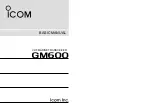
IM 01C25F01-01E
5-1
5. INSTALLING IMPULSE PIPING
5.
INSTALLING IMPULSE PIPING
5.1 Impulse Piping Installation
Precautions
The impulse piping that connects the process outputs to
the transmitter must convey the process pressure
accurately. If, for example, gas collects in a liquid-
filled impulse line, or the drain for a gas-filled impulse
line becomes plugged, it will not convey the pressure
accurately. Since this will cause errors in the measure-
ment output, select the proper piping method for the
process fluid (gas, liquid, or steam). Pay careful
attention to the following points when routing the
impulse piping and connecting the impulse piping to a
transmitter.
5.1.1 Connecting Impulse Piping to a
Transmitter
IMPORTANT
The transmitter can be installed in horizontal
impulse piping configuration, tilting the
transmitter's position up to 90
°
. When tilting,
observe that the pipe (for Model EJX530A with
measurement span code A, B, and C) is posi-
tioned horizontal downwards, or any place
between them, as shown in Figure 5.1 The
zero-adjustment screw must be positioned
downwards for all the models.
F0501.EPS
If the zero-adjustment screw is positioned other than
donwards after installation, rotate the housing unitl it is
positioned downwards.
The pipe (open to atmosphere) is positioned horizontal.
Zero-adjustment screw
Pipe
(backside of the instrument)
Figure 5.1
Horizontal Impulse Piping Connection
5.1.2 Routing the Impulse Piping
(1) Process Pressure Tap Angles
If condensate, gas, sediment or other extraneous
material in the process piping gets into the impulse
piping, pressure measurement errors may result. To
prevent such problems, the process pressure taps must
be angled as shown in figure 5.2 according to the kind
of fluid being measured.
NOTE
• If the process fluid is a gas, the taps must be
vertical or within 45
°
either side of vertical.
• If the process fluid is a liquid, the taps must be
horizontal or below horizontal, but not more
than 45
°
below horizontal.
• If the process fluid is steam or other condens-
ing vapor, the taps must be horizontal or above
horizontal, but not more than 45
°
above hori-
zontal.
[Gas]
Pressure
taps
Process
piping
[Steam]
[Liquid]
45
°
45
°
45
°
45
°
45
°
45
°
F0502.EPS
Figure 5.2 Process Pressure Tap Angle (For Horizontal
Piping)
(2) Position of Process Pressure Taps and
Transmitter
If condensate (or gas) accumulates in the impulse
piping, it should be removed periodically by opening
the drain (or vent) plugs. However, this will generate a
transient disturbance in the pressure measurement, and
therefore it is necessary to position the taps and route
the impulse piping so that any extraneous liquid or gas
generated in the leadlines returns naturally to the
process piping.
• If the process fluid is a gas, then as a rule the
transmitter must be located higher than the process
pressure taps.
• If the process fluid is a liquid or steam, then as a
rule the transmitter must be located lower than the
process pressure taps.
















































